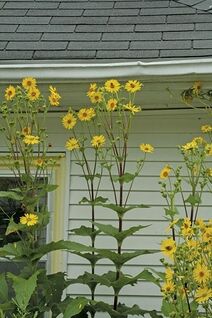Silphium perfoliatum
| Silphium perfoliatum | |
 | |
| Light: | |
| Moisture: | |
| Hardiness: | 4 |
| Soil pH: | 5.6-8.4 |
| Height: | 8' |
| Blooms: | Mid Summer |
| Native to: | |
| Nectary | |
| Medicinal Rating: | |
| Tea: | Yes |
Silphium perfoliatum (common name: cup plant)
Propagation: Seed - best sown as soon as it is ripe in a greenhouse[1]. Prick out the seedlings into individual pots as soon as they are large enough to handle and plant them out in the summer.
Division in spring[2]. This is very difficult due to the deep and extensive root system.
Cultivation: Succeeds in any ordinary garden soil[3]. Prefers a deep moisture retentive moderately fertile soil that is not too nitrogen rich, in sun or dappled shade[1].
Hardy to at least -25°c[4].
Plants have a deep and extensive root system which makes transplanting difficult.
An aromatic resin exudes from the crushed leaves and stems[5].
Range: Eastern N. America - Ontario to South Dakota, south to Georgia, Missouri and Oklahoma.
Habitat: Rich woods, thickets, river banks and prairies[6].
Medicinal: Cup plant was employed medicinally by several native North American Indian tribes who used it to treat a variety of complaints[7]. It is little, if at all, used in modern herbalism. A decoction of the root has been used to treat the stoppage of periods, and also to treat morning sickness and to prevent the premature birth of a child[7]. In view of these conflicting uses, it is best that it is not used by pregnant women unless under the guidance of a qualified practitioner[7].
The root is alterative, antispasmodic, diaphoretic, emmenagogue, febrifuge, hepatic, stimulant, styptic and tonic. It is used in the treatment of liver and spleen disorders and has also been used to treat morning sickness[8][9][7]. A decoction of the root has been used internally in the treatment of back and chest pain and lung haemorrhages[7]. A decoction of the root has been used as a face wash to treat paralysis[7]. A poultice of the moistened dried root has been applied to wounds to stop the bleeding[7].
Pollinators: Insects
Soil: Can grow in light, medium, and heavy soils.
Seed Ripens: Late Summer
Flower Type: Hermaphrodite
Links
References
- ↑ 1.0 1.1 Huxley, Anthony. The New Royal Horticultural Society Dictionary of Gardening. MacMillan Press, 1992.
- ↑ Brickell, Christopher. The RHS Gardener's Encyclopedia of Plants and Flowers. Dorling Kindersley Publishers, 1990.
- ↑ Chittendon, Fred. RHS Dictionary of Plants. Oxford University Press, 1951.
- ↑ Phillips, Roger and Martyn Rix. Perennials - The Definitve Reference. Pan Books, 1991.
- ↑ Genders, Roy. Scented Flora of the World. Robert Hale, 1994.
- ↑ Lyndon, Merritt. Gray's Manual of Botany. American Book Co, 1950.
- ↑ 7.0 7.1 7.2 7.3 7.4 7.5 7.6 Moerman, Daniel. Native American Ethnobotany. Timber Press, 1998.
- ↑ Grieve, Margaret. A Modern Herbal. Penguin, 1984.
- ↑ Usher, George. A Dictionary of Plants Used by Man. Constable, 1974.